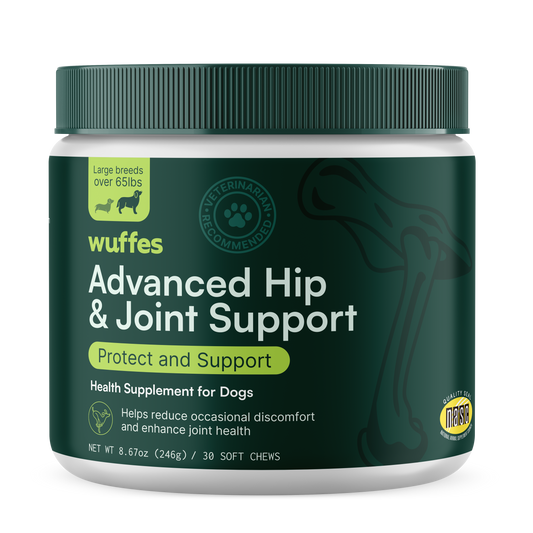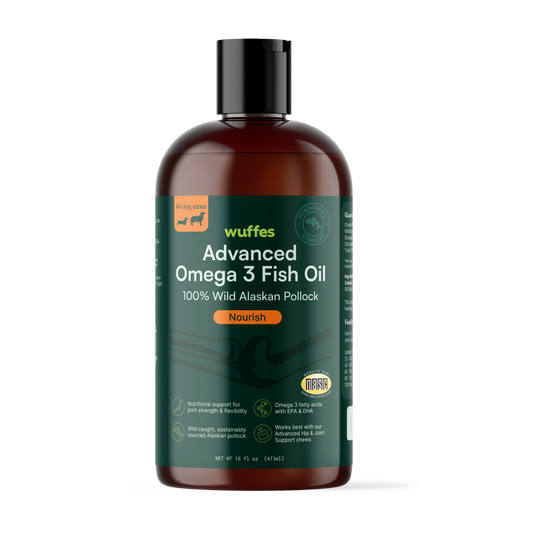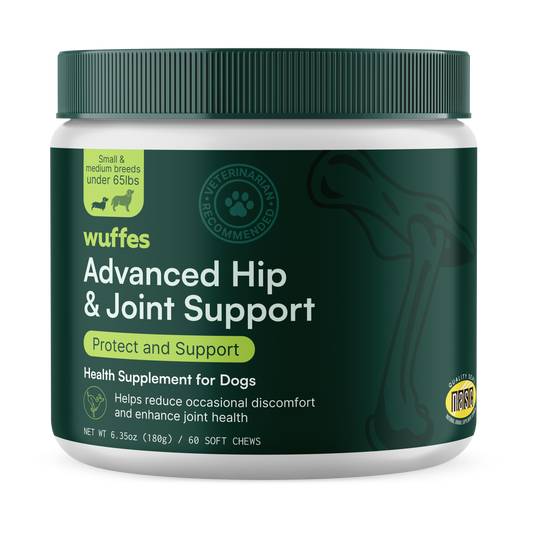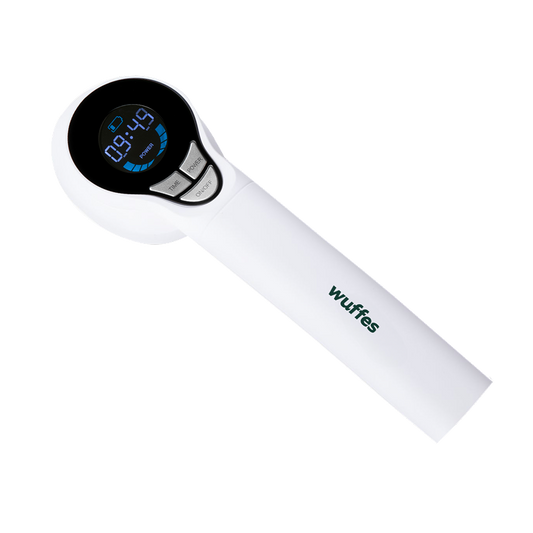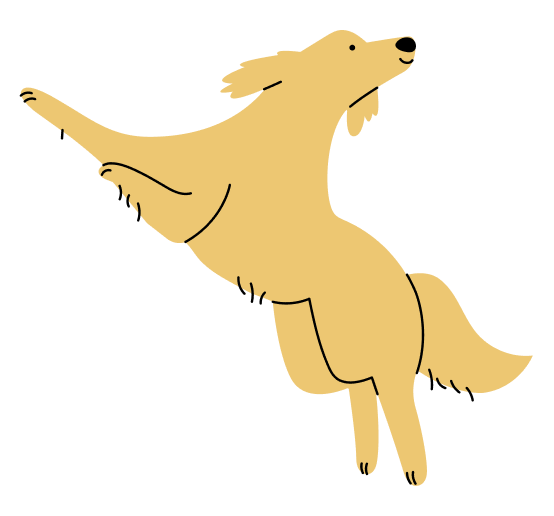Is your dog limping on a front leg, reluctant to play, or slow to rise after rest? These may be early signs of elbow dysplasia (ED), a group of developmental joint conditions that leads to chronic pain.[1][2] Surprisingly to most pet owners, this joint disorder affects young dogs. Later in life, dogs with elbow dysplasia may limp secondary to arthritis.
What is Elbow Dysplasia?
Elbow dysplasia isn’t a single condition - it’s a family of orthopedic issues that affect how the bones of the elbow joint (the humerus, radius, and ulna) fit and function. Dogs with elbow dysplasia have at least 1 of the following components:
Fragmented Medial Coronoid Process (FCP)
Small bone fragments break off inside the elbow. This is the most common form.
Osteochondritis Dissecans (OCD)
A flap of cartilage separates from the underlying bone.
Ununited Anconeal Process (UAP)
A growth plate fails to close, leaving a loose piece of bone.
Joint Incongruity
A mismatch in how the elbow bones fit together, putting uneven pressure on joint surfaces.
Regardless of which of these components your dog has, they all cause inflammation, discomfort, and arthritis.[2]
Why it happens
Elbow Dysplasia is multifactorial: genetics, rapid growth, overnutrition, and inappropriate exercise during puppyhood all play a role. High-calorie or calcium-rich diets and too much high-impact play can overload a growing skeleton.[3] Because elbow dysplasia is hereditary, it is recommended that dogs with this condition are not bred.[4]
Affected Breeds
Large breed dogs such as Labradors, Bernese Mountain Dogs, and Rottweilers are most reported, but can also occur in small breed dogs.[2][3]
Clinical signs
Most dogs with ED typically begin showing signs between 6 and 12 months of age, but some dogs are not symptomatic until later in life as arthritis progresses.[3] Signs include:
- Intermittent or persistent front leg lameness
- Stiffness after rest
- Outwardly rotated elbows when walking or resting
- Reduced elbow range of motion
Some owners notice that lameness worsens with intensive activities such as ball play or roughhousing with other dogs.
Diagnosis & treatment options
- Diagnosis usually begins with radiographs (X-rays). However, advanced imaging such as CT “CAT scan” or arthroscopy may be required for earlier detection.[2]
- Arthroscopic Surgery is sometimes recommended in young dogs - especially for removing bone fragments (FCP), cartilage flaps (OCD), or fixing UAPs. However, the long-term benefit of surgery varies depending on the specific form of ED and the degree of arthritis already present. [5] [6] [7]
- Total elbow replacement exists in dogs, but is rare and carries high complication rates. [8][9]
Conservative management & medical therapies
In many dogs, non-surgical care is the cornerstone of long-term management.
Weight Management
Extra weight adds stress and inflammation on joints. Helping your dog stay lean is one of the most powerful ways to reduce discomfort and slow joint damage.
Low-Impact Exercise
Controlled activity is crucial. Avoid repetitive ball throwing or jumping, and instead focus on low-impact activities like swimming or underwater treadmill therapy. One study showed that 20 minutes of swimming immediately increased elbow range of motion in both healthy dogs and dogs with elbow dysplasia![10]
Joint Supplements
Joint supplements with ingredients like omega-3s, UC-II, green-lipped mussel, glucosamine and chondroitin, and hyaluronic acid can help support joint health.[11][12] These supplements provide the most benefit when used in early stages of arthritis.
Pain Management
Pain control is essential for improving quality of life in dogs with ED. Keeping your dog comfortable will enable them to participate in exercise that maintains joint range of motion and health. Pain management can be in the form of prescription medications or modalities (such as laser therapy and acupuncture).
Joint Injections
When oral medications and supplements aren’t enough, intra-articular (joint) injections can provide targeted relief. Injection options include steroids, hyaluronic acid, regenerative medicine (stem cells or platelet products), and/or hydrogels.[13]
The bottom line
Elbow dysplasia is not curable, but it is very manageable. Whether your dog is newly diagnosed or already living with arthritis, the right multimodal care plan can preserve mobility and reduce pain for years to come.
References
- Harari, J. (2020). Elbow Dysplasia in Dogs. Merck Veterinary Manual. https://www.merckvetmanual.com/musculoskeletal-system/arthropathies-and-related-disorders-in-small-animals/elbow-dysplasia-in-dogs
- Duerr. (2020). Elbow Region Canine Lameness. John Wiley & Sons.
- Michelsen. (2013). Canine elbow dysplasia: Aetiopathogenesis and current treatment recommendations. Veterinary Journal, 196(1), 12–19.
- Binversie, E. E., Momen, M., Rosa, G. J., Davis, B. W., & Muir, P. (2022). Across-breed genetic investigation of canine hip dysplasia, elbow dysplasia, and anterior cruciate ligament rupture using whole-genome sequencing. Frontiers in Genetics, 13, 913354.
- Burton, N. J., Owen, M. R., & Kirk, L. S. (2011). Conservative versus arthroscopic management for medial coronoid process disease in dogs: A prospective gait evaluation. Veterinary Surgery, 40(8), 972–980.
- Dempsey, L., Maddox, T., Comerford, E., Pettitt, R., & Tomlinson, A. (2019). A comparison of owner-assessed long-term outcome of arthroscopic intervention versus conservative management of dogs with medial coronoid process disease. Veterinary and Comparative Orthopaedics and Traumatology, 32, 001–009.
- Kähn, H., Zablotski, Y., & Meyer-Lindenberg, A. (2023). Therapeutic success in fragmented coronoid process disease and other canine medial elbow compartment pathology: A systematic review with meta-analyses. Frontiers in Veterinary Science, 10, 1228497.
- De Sousa, R. J., Parsons, K. J., Owen, M. R., Grierson, J., McKee, W. M., Kulendra, E., & Burton, N. J. (2016). Radiographic, surgeon and owner assessment of the BioMedtrix TATE® Elbow Arthroplasty. Veterinary Surgery, 45(6), 726–735.
- Danielski, A., Krekis, A., Yeadon, R., Solano, M. A., Parkin, T., Vezzoni, A., & Pfeil, I. (2022). Complications after proximal abducting ulnar osteotomy and prognostic factors in 66 dogs. Veterinary Surgery, 51(1), 136–147.
- Preston, T., & Wills, A. P. (2017). A single hydrotherapy session increases range of motion and stride length in Labrador retrievers diagnosed with elbow dysplasia. Veterinary Journal (London, England : 1997), 234, 105–110. https://doi.org/10.1016/j.tvjl.2018.02.013
- McCarthy, G., O’Donovan, J., Jones, B., McAllister, H., Seed, M., & Mooney, C. (2007). Randomised double-blind, positive-controlled trial to assess the efficacy of glucosamine/chondroitin sulfate for the treatment of dogs with osteoarthritis. The Veterinary Journal, 174(1), 54–61. https://doi.org/10.1016/j.tvjl.2006.02.015
- Barbeau-Grégoire, M., Otis, C., Cournoyer, A., Moreau, M., Lussier, B., & Troncy, E. (2022). A 2022 Systematic Review and Meta-Analysis of Enriched Therapeutic Diets and Nutraceuticals in Canine and Feline Osteoarthritis. International Journal of Molecular Sciences, 23(18), 10384. https://doi.org/10.3390/ijms231810384
- Lotsikas, P. J. (2022). Intra-articular Injectates What to Use and Why. Veterinary Clinics of North America: Small Animal Practice, 52(4), 967–975. https://doi.org/10.1016/j.cvsm.2022.03.004
Dr. Jennifer Repac
DVM, DACSMR, CVA, CCRT, CVCH



